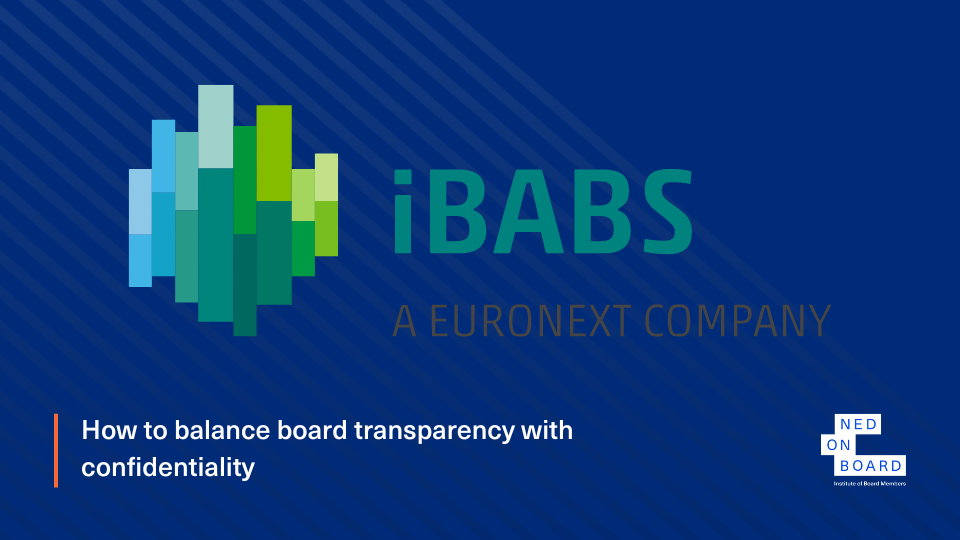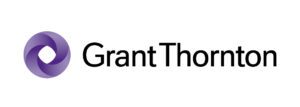How to balance board transparency with confidentiality
Given the board’s role in driving the company towards its goals, it is understandable that stakeholders demand to know that directors are performing to the best of their abilities. By practising board transparency, management can reassure shareholders and other interested parties that the processes at the top are setting the correct culture for a successful organisation.
iBabs’ recent executive meeting insights survey highlighted some worrying trends that would cause concern for boards and stakeholders if they were evident at their organisation. They include:
- 35% of respondents said minutes were not routinely taken and distributed in meetings
- Less than half of participants said that action points were tracked and followed up on
- Nearly a quarter of meeting participants did not have access to information soon enough to prepare properly for meetings.
Where there is transparency, these issues can be addressed. Where there is not, the organisation can suffer from suboptimal board performance as a result.
This article begins with and analyses the importance of board transparency, ways to improve it, as well as addressing challenges that organisations face in instilling the optimal level of accountability. We recommend reading in full for a rounded overview of balancing board transparency with confidentiality.
The importance of board transparency today
The emphasis on a company’s dedication to ESG factors, including how it implements good corporate governance, is high in the minds of both shareholders and regulators today. And that means that the board needs to be transparent in the way it carries out its duties.
Attitudes over transparency have changed over time for customers and employees, too. A recent survey found that millennials value a company being open about its values and culture, with 84% saying they would be more loyal [1] to an organisation that demonstrated transparency. Furthermore, three-quarters of respondents would take one job offer over another based on the employer’s transparency, with 74% saying they wished their current employer was more transparent.
With the board setting the tone for the organisation, they cannot afford to ignore this desire for directors to be seen to act in an open and honest manner.
How to achieve board transparency in practice
Publish meeting minutes
Although stakeholders cannot attend board meetings to watch the decision-making process first-hand, the minutes of the meeting are an invaluable insight into what happened and the reasoning behind the way that the board voted.
By publishing your meeting minutes (or a summary of them) for stakeholders to read, you show transparency over the discussion that takes place around the table. You also give them an insight into why the board believes its decisions are in the best interests of the organisation.
Proactively share financial reports
Of course, it is natural to want to spin bad news to soften the impact and potential pushback from shareholders. However, when boards are reluctant to reveal the full details of their financial reports, it can lead to suspicion and make some investors feel as if they are being denied the complete story.
With full disclosure of the results, you get to lead the narrative, both negative and positive. For disappointing figures, it is an opportunity to communicate the contributing factors and the board’s plan to remedy the situation. This transparency also leads to greater trust when you actively promote better-than-expected results.
Proactively share non-financial reports
Financials are not the only important metrics for stakeholders today. Non-financials such as ESG performance, CSR activities, sustainability efforts and other aspects of the company’s work are also under scrutiny.
For example, sustainable investors want to know that a board is not just talking a good game about its measures to reduce its environmental impact. Transparency in its efforts helps to prove that it is making a tangible difference and not simply greenwashing [2].
Engage shareholders
Of course, the company should hold an annual general meeting to allow shareholders to question executives, but investor engagement should not be limited to this yearly event. Not being accessible to shareholders is a surefire way to reduce trust in your organisation.
Create an investor relations strategy [3] to keep your company in the minds of shareholders and to ensure they feel that they have open lines of communication if they have any questions or concerns. Also remember to get out for roadshows and other events to prove your commitment to transparency.
Disclose the board selection process
The composition of the board has a significant bearing on the effectiveness of its work and, in turn, the performance of the business. As such, stakeholders have a right to know your criteria for selecting new members and the process by which you onboard them in order for them to hit the ground running.
Show the steps that the nomination committee takes to identify skills gaps, evaluate new members, implement diversity and inclusion policies, as well as your procedures for training, developing and orienting new directors. This will give stakeholders a better understanding of the way your board works.
Publicise executive compensation
Director remuneration can be a contentious topic within organisations where there is little transparency. It is right that executives receive commensurate compensation for their work, but when there is no clear evidence of pay being linked to performance, it can undermine the perceived integrity of the board.
By showing detailed information about the compensation packages of its top executives, including salary, bonuses, stock options and other benefits, as well as the KPIs that they hit to achieve their package, it displays a commitment to transparency and accountability. There is no concern that directors are happy to sit back and wait for a paycheque; they are shown to be rewarded for the work they put into driving the company forwards.
Address issues instantly
Issues arise at any organisation from time to time, but it is how you handle these challenges that matters most to the transparency of your board. Rather than trying to hide a story, it makes more sense to inform stakeholders of what has happened and how the board is dealing with it.
If it were to come out that the board had tried to keep an issue from becoming public, this could damage trust in the organisation. It is better to be transparent and assure your stakeholders that they do not need to worry about any additional obstacles that are being kept under wraps.
Share relevant documentation and evaluations
Being transparent about the workings of the board means letting stakeholders understand the processes by which you work. This includes publishing documentation such as by-laws, corporate governance guidelines and ethics policies on your website for anyone to view.
In addition, when you carry out board evaluations, share the reports online. This allows viewers to see how the board is performing, where it is excelling and where it needs to improve. They can then hold the board to account for its efforts to raise its performance and improve effectiveness before the next evaluation.
Discuss risk management
In your annual report, make sure to discuss your strategies and practices for risk management. This aspect of transparency is essential for investors who want to understand the process the board utilises to identify and mitigate risks.
Be open about the methodology you use and assure your stakeholders that you have a robust process in place to avoid unnecessary risk for the company.
Examples of board transparency
Here are some boards renowned for their transparency and the reasons that they have gained this reputation:
| Company | Reason |
| Chubb | The insurance company won the category for Best Investor Relations Website at the 2022 Labrador Transparency Awards . The judges praised it for clearly identifying and providing “access to sustainability or corporate responsibility information,” noting it was one of the few IR sites to provide an annual meeting subsection with a link to voting reports. |
| Change.org | Change.org’s impact report is a transparent document that details financial reporting as well as detailed information on the petition platform’s diversity and inclusion vision and focus. It gives a clear indication of what drives decision-making in the organisation. |
| Buffer | In the social media scheduling tool’s Transparency section, the salaries of all team members are listed, as are financial reports, details of when team members have taken time off and a blog explaining many of the company’s corporate governance practices. The firm says “we believe in the power of transparency to build trust, hold us accountable to a high standard, and push our industry forward.” |
| Patagonia | Clothing company Patagonia is known for backing activism around the world and is transparent in detailing the criteria it uses to decide on which causes to invest in. This helps stakeholders understand who the business will associate with and consider whether this fits with their ethical outlook. |
| Diageo | Drinks company Diageo provides clarity on its governance policies, including an in-depth remuneration report to show the criteria for directors achieving their compensation packages and the value of those packages. |
Challenges to Board transparency
- Confidentiality concerns: Balancing transparency with the need to protect sensitive information can be a challenge. Boards often deal with confidential matters that they should not disclose, and committing to the right level of transparency without compromising confidentiality requires careful consideration.
- Information overload: Providing too much information to stakeholders can reduce some of the impact. There are many aspects to a board’s workflow that they need to know, so presenting it in a clear and digestible manner is essential.
- Lack of technology: Some organisations may struggle with outdated technology, making it difficult to share information effectively and in a timely manner. This can hinder transparency efforts. Using a board portal captures decisions and documents, agendas, minutes and action points in a central repository that makes it easier to share them with stakeholders.
- Resistance to change: Board members or leadership may resist adopting more transparent practices due to fear of scrutiny or a longstanding culture of secrecy within the organisation.
- Inadequate communication: Poor communication can lead to misunderstandings and mistrust. Boards need clear and effective communication channels with stakeholders to ensure accuracy and transparency.
FAQ
What are the potential risks of excessive transparency?
While transparency is generally positive, excessive transparency can pose risks such as the potential for sensitive information to fall into competitors’ hands, overwhelming stakeholders with too much information, or creating confusion by releasing uncontextualised or premature data. It can also lead to a focus on short-term issues at the expense of long-term strategy.
What is the most critical aspect of board transparency?
The most critical aspect of board transparency is the accurate and timely disclosure of information that is relevant to stakeholders’ understanding and assessment of the board’s governance and the company’s performance. This includes financial reporting, disclosure of conflicts of interest, executive compensation and key decisions made by the board.
How does board transparency impact corporate reputation?
Board transparency positively impacts a company’s reputation. Transparent practices build trust among stakeholders, demonstrate a commitment to ethical governance, and show accountability.
A good reputation fostered by transparency can lead to increased investor confidence, customer loyalty and the ability to attract and retain top talent. Conversely, a lack of transparency can damage a company’s reputation and lead to distrust among stakeholders.
Conclusion
Of course, it makes no sense for a company to reveal all details of its actions to the public, as that would overexpose it to scrutiny from competitors. However, board transparency whereby there are direct lines of communication to key stakeholders over the overarching governance efforts of the organisation is essential to instil confidence and trust in the board of directors.
NEDonBoard, Institute of Board Members has partnered with iBabs to address this board level theme. Interested to know more? Request a demo of iBabs for your company today. Using a board portal such as iBabs to capture decisions, evaluate the performance and engagement of directors and store important information in an easy-to-search manner, helps the board be transparent with its stakeholders.
Related resources:
7 steps to strengthen Board relations for effective governance
[1] https://www.benefitspro.com/2021/05/26/millenials-are-all-in-on-transparency-and-companies-need-to-follow-suit/?slreturn=20240508101937
[2] https://www.un.org/en/climatechange/science/climate-issues/greenwashing
[3] https://www.companywebcast.com/investor-relations/the-investor-relations-best-practice-guide-for-modern-iros/




